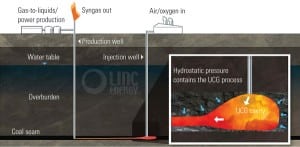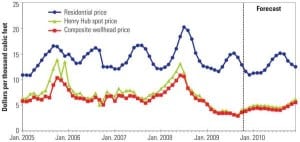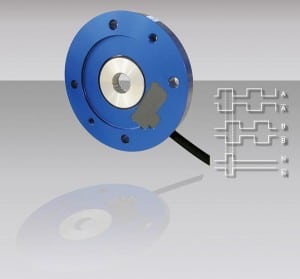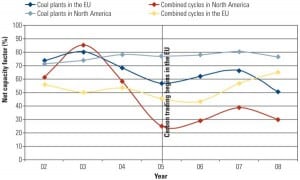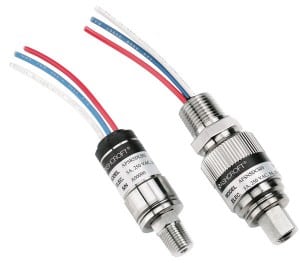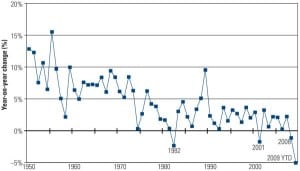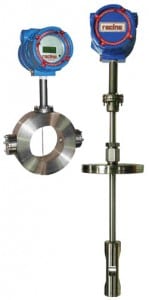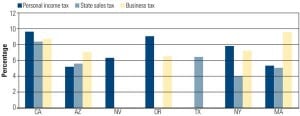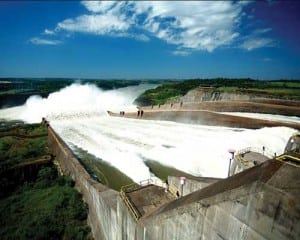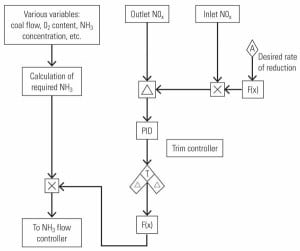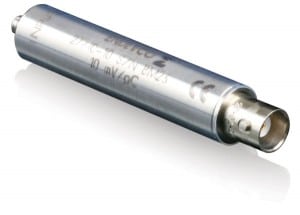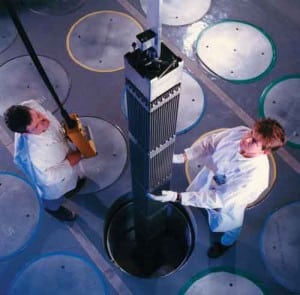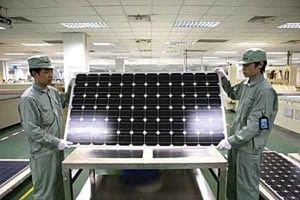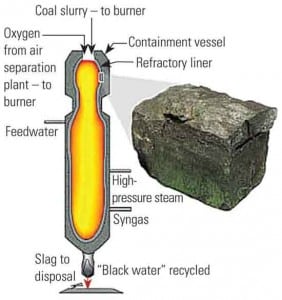In This Issue
-
Coal
The Resurrection of Underground Coal Gasification
News this past November that Australian company Cougar Energy had begun developing a pilot project to generate power from coal still underground has reignited interest in the 100-year-old alternative energy technology. The company’s planned A$8 million program — expected to be started in the first quarter of 2010 — will be conducted 10 kilometers south of Kingaroy, in southern Queensland. If it is successful, it could lead to the establishment of a 400-MW baseload power station, Cougar Energy officials say.
-
Nuclear
High-Temperature Gas-Cooled Reactor Concept Moves Forward
Researchers from the Idaho National Laboratory (INL) say they have developed a new type of nuclear fuel for use in next-generation high-temperature gas reactors that produces less waste — a major step forward for the Next Generation Nuclear Plant (NGNP).
-
O&M
Replacing an HP/IP Rotor
Today’s power plant owners face many challenges, including the aging and degradation of equipment. Steam turbines at times may be condemned due to operating inefficiency or rising vibration levels. In such cases the options may be few because the turbine may require a full or partial rotor section replacement. The good news is that a rotor section replacement can be performed in a relatively short time, depending upon the original rotor configuration. Here’s one example.
-
News
Predicting Hurricane-Related Outages
Researchers from John Hopkins and Texas A&M universities say that they have found a way to accurately predict power outages in advance of a hurricane. Computer models developed using data from Hurricane Katrina and four other destructive storms could save utilities substantial amounts of money and help facilitate rapid restoration of power after a storm, they say.
-
Legal & Regulatory
GHG Emissions Reporting Begins Jan. 1
Last fall, the U.S. Environmental Protection Agency (EPA) issued a rule creating a mandatory national system for reporting greenhouse gas (GHG) emissions. The agency requires regulated entities to begin monitoring GHG emissions January 1, 2010, and to submit their first annual emissions reports March 31, 2011. This is a key step toward federal regulation of GHG emissions (a step that may have major implications regarding "major sources" and permitting requirements for new sources). It’s also an opportunity for power producers to implement their inventory management plans.
-
O&M
Sealing Transformer Oil and SF6 Leaks Quickly and Effectively
Transformers, which are prone to leaking, are an excellent example of where using the right materials and techniques can quickly reduce cleanup costs and potential environmental damage from a fluid leak. Transformer leaks are most commonly caused by degrading cork gaskets or holes in the radiator fins or the steel tank. Often these leaks are slow drips, but occasionally a catastrophic leak will occur, spilling hundreds of gallons of mineral oil into the environment and causing the transformer to short-circuit, causing further health and safety concerns. These dangers, coupled with transformers’ isolated locations, make inspection, repair, and maintenance a major challenge.
-
O&M
The U.S. Gas Rebound
"It’s déjà vu all over again," said Yogi Berra. The Hall of Fame catcher could easily have been predicting the coming resurgence of natural gas – fired generation. Yes, a few more coal plants will be completed this year, but don’t expect any new plant announcements. A couple of nuclear plants may actually break ground, but don’t hold your breath. Many more wind turbines will dot the landscape as renewable portfolio standards dictate resource planning, but their peak generation contribution will be small. The dash for gas in the U.S. has begun, again.
-
O&M
When to Use an Oil Skimmer
Oil skimmers are very effective in removing oil from wastewater before discharge but are also perhaps the most efficient and economical approach.
-
Environmental
A New Regulatory and Environmental Milieu
There will be no shortage of important issues to keep utility executives and their staffs busy throughout 2010. Few of these will be surprises, although a number will emerge quickly and assume larger-than-life significance. The confluence of the great recession and the sturm und drang of environmental legislation will create the liveliest of the debates, but more subtle trends will drive additional stressors. The results of Black & Veatch’s 2009 fourth annual industry strategic directions survey can offer guidance as to how these issues will affect the industry in the coming year.
-
News
Thin, Flange-Style Magnetic Encoders
Baumer introduced the new MOR 90 and MOR 105 magnetic incremental encoders for improved speed and position control on electric motors, drives, gearboxes, and conveyors. Measuring just 14 mm thick, these extremely thin, flange-style encoders are virtually imperceptible when positioned between the motor and the gearbox and have little effect on the overall size of […]
-
Coal
The Impact of Carbon Trading on Performance: What Europe’s Experience Can Teach North American Generators
The European carbon trading system experience suggests that North American generators should expect severely altered coal-fired power plant operating profiles if cap-and-trade legislation becomes law. In a groundbreaking study, Solomon Associates predicts the reduction in mean run time that North American generators should expect. The trends outlined in this study provide an overview of some of the broad challenges facing generators in moving to a carbon-constrained market environment.
-
News
Miniature Stainless Steel Pressure Switch
Ashcroft A-Series pressure switches are designed for tough OEM and industrial applications that require a durable, high-quality miniature switch. Available with explosion-proof and watertight enclosures, the pressure switch features a refined piston actuator that can be ranged up to 2,000 psi while enduring a working pressure of 5,000 psi. Small dimensions, a choice of connections, […]
-
Solar
A New Foundation for Future Growth
As the economy begins to grow again, the banking industry continues to stabilize, and lawmakers work on finalizing climate change legislation, the decisions made in 2010 will lay the foundation for the power industry for decades to come.
-
News
Flowmeters for Steam Measurement
Racine Vortex released its RNS Series (Insertion) and RWS Series (Wafer) Vortex Steam Flow Meters to measure noncondensing steam and saturated process steam at pressures up to 150 psi for applications such as boiler monitoring. Both meters have no moving parts and are loop-powered devices with standard HART communication for ease of field programming and […]
-
Business
Dollars and Dirt: Investing in Infrastructure
The familiar saying "as goes California, so goes the nation" seems to apply to the many states that have been unable to invest in infrastructure improvements because they are crushed by debt and shrinking revenues. Will California and energy project developers continue to invest in energy infrastructure in 2010 given the limited availability of private capital, shaky state finances, and shifting regulatory climate?
-
-
Smart Grid
The Smart Grid Has a Growth Spurt
Which country has the smartest grid? Which U.S. state has the most smart meters? What’s Google got to do with the grid? Answers to these questions and more can be found in our web exclusives. Here’s a taste of what you’ll find online.
-
Coal
Brazil: Latin America’s Beacon
With the eighth-largest economy in the world, Brazil has a clear need for power, but balancing supply and demand has proven tricky in recent decades. Even in a country where over 80% of generation capacity comes from renewables, planning for future capacity additions isn’t straightforward or easy.
-
Coal
Tuning Ammonia Flow to Optimize SCR Performance
The selective catalytic reduction system has become ubiquitous throughout the world of power plants. Emission control requirements are ever-more stringent, and the cost of excursions is becoming increasingly high. The key to staying under the regulators’ radar is precisely controlling the ammonia injected into the boiler. A new control strategy does precisely that.
-
News
Low-Noise Remote Charge Converter
Endevco Corp. launched Model 2771C-XX, an ultra-low-noise remote charge converter (RCC) designed for use with charge output piezoelectric sensors within applications such as nuclear power plant/regenerative energy and environmental testing. The model offers a rugged two-wire (IEPE), single-ended design that operates from constant current power (4-20 mA). Both RCC signal output and current to the […]
-
Smart Grid
U.S. Smart Grid Forecast: Flurries of Activity
A number of factors are coalescing to create the most hospitable climate for smart grid development activities that has yet been seen in the U.S. Here’s a look at those elements and at the different models and motivations for smart grid project development across the country.
-
Commentary
Carbon-Cutting Solution: Dynamic Demand Technology
Once upon a time, climate change felt like a distant threat on the horizon. Now it is happening in front of our very eyes. Across the world, global warming is sparking more intense heat waves, more flooding, and more droughts. If climate change continues at its current pace, the social, environmental, and economic costs don’t […]
-
Smart Grid
What Do Customers Expect from the Smart Grid?
Xcel Energy’s SmartGridCity enterprise in Boulder, Colo., is one of the most talked-about smart grid projects. Here’s what some Boulder utility customers are saying about it.
-
Nuclear
Japan Launches Commercial Operation of MOX-Fueled Reactor
Japan began operating a nuclear power reactor using plutonium-uranium mixed oxide (MOX) as fuel for the first time last October. About 16 MOX-containing fuel assemblies were loaded during a scheduled outage to replace a portion of the 193 fuel assemblies at the No. 3 reactor at Kyushu Electric Power Co.’s Genkai nuclear power plant. The utility eventually plans to triple the number of fuel assemblies at the 1,180-MW reactor in Saga Prefecture to 48. The Ministry of Economy, Trade and Industry conducted its final inspection of the reactor and issued its certification on Dec. 2.
-
Solar
Which Country’s Grid Is the Smartest?
The U.S. isn’t the only country evaluating and implementing elements of smart grid technology. In fact, it could be argued that other nations are much farther along the path to a comprehensive, technically advanced system for integrating renewables, managing load, and creating a more flexible power grid.
-
Solar
China’s Largest PV Maker to Set Up in Arizona
China’s largest solar panel maker, Suntech Power, in mid-November announced plans to open a photovoltaic (PV) manufacturing facility in Phoenix, Ariz., in the third quarter of 2010. Roger Efrid, Suntech’s managing director, was widely quoted as saying that the company — which holds 12% of U.S. market share and is looking to reach 20% by 2010 — chose to establish a plant nearer to customers. This was smart business, even though panels would be made from solar cells imported from China, because solar panels are heavy, he told The New York Times: "As the price of solar panels has reduced dramatically in the last 12 months, the shipping costs have become a larger and larger portion of the overall cost of getting these projects to market."
-
Smart Grid
My Top 10 Predictions for 2010
David Letterman has entertained us with his “Late Show” Top Ten list since 1985. In keeping with this issue’s theme of forecasting the future of the power industry, I’m going to step out with my top 10 list of what to expect in the next 12 months. 10. New Nuclear Will Progress Slowly. I don’t […]
-
Coal
Advanced Refractory Lining Improves Gasifier Reliability
Successful testing of a new refractory lining material developed by the Office of Fossil Energy’s National Energy Technology Laboratory (NETL) could lead to higher reliability and improved economics of gasification technology.


